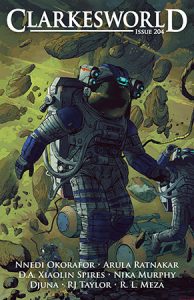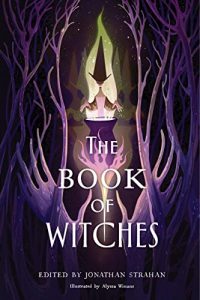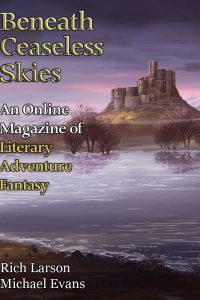A.C. Wise Reviews Short Fiction: Asimov’s and Clarkesworld
 Asimov’s 9-10/23
Asimov’s 9-10/23
Clarkesworld 8/23, 9/23
Asimov’s “Slight Spooky” September/October 2023 issue starts off strong with the novelette “Deep Blue Jump” by Dean Whitlock. The story is set amongst a group of children who have been sold or abandoned into a life of harvesting drug-like dream berries. The conditions are brutal, working long hours, risking their lives climbing on dangerous vines to reach the berries, and watched over by slappers who will shoot them if they fall out of line. Kim leads her team, doing her best to keep the other children safe, but when Mira, her second in command, is lost while picking, things on her team begin to fall apart. The descriptions are vivid and effective, and Whitlock does a wonderful job investing the reader in the characters’ lives and struggles while exploring issues of forced labor, the class divide, addiction, grief, and capitalistic greed. Despite the grim subject matter though, a note of hope does run through the story as well.
Michèle Laframboise’s novelette “Tears Down the Wall” is another standout in the issue, similarly exploring the divide between the haves and the have-nots, but taking more of a cyberpunk/noir-inflected procedural approach. A few elite corporate families control all the wealth, and housing has become so expensive that even gainfully employed people are often forced to live in small, portable tents that are hoisted up the sides of skyscrapers at night, then lowered again in the morning – a sight that tourists come to watch and even find beautiful, as they look like the titular tears descending the walls. When a tent falls and its occupant is killed, the protagonist is sent to investigate. It seems the dead man was an activist, stirring up social unrest, and his death may have been politically motivated. But as the investigation continues, it’s revealed that there’s far more than a possible murder at play, and nothing is quite what it seems. The story takes several satisfying twists and turns, and the world building is nicely done, providing a lush backdrop against which the mystery gradually unfolds.
The issue includes two additional novelettes, a handful of short stories, and closes out with a novella by Kristine Kathryn Rusch about a heist to recover a stash of powerful weapons from an auction warehouse where they are set to be sold as curious artifacts by people oblivious to their destructive potential. “The Dead Letter Office” by David Erik Nelson is one of the few stories that actively leans into the “slightly spooky” label on the issue, but it felt a touch uneven in its tone with the somewhat jokey conceit of misspelled letters to Santa addressed as letters to Satan set against the serious theme of revenge porn. Derek Künsken’s piece “Six Instances of Evolution Using Time Travel” posits the intriguing concept of a parasite that changes the behavior of other species in order to propagate itself, much like the cordyceps fungus, but in this case, the behavior it seeds across worlds is the impetus to invent time travel. As one of the shortest pieces in the issue, it doesn’t develop the idea into a fully fledged story, but the idea itself is still a cool one.
The August 2023 issue of Clarkesworld contains several stories and novelettes exploring humanity’s relationship with technology and its potential impact on various fields including art, education, and medicine. “Empathetic Ear” by M.J. Pettit explores how AI chatbots might be deployed in a university setting. Anais is a professor who moved to England, already viewed with suspicion post-Brexit, and on probation after several low ratings from her students who, in her opinion, are upset at her refusal to simply hand out good grades whether they’re earned or not. The dean makes a deal with her – if she agrees to an experimental study, wearing an Empathetic Ear, a device meant to analyze conversations and situations, and tap into her subvocalized thoughts to nudge her into make more compassionate choices, she may earn her way out of her probation. Pettit offers an interesting and timely look at the line between technology and humanity, exploring the question of when AI assistance crosses the line into the machine taking over. The story also tackles the ethics of AI, as Anais’s experiences with the device are used to train and improve it without her knowledge. Some good does come out of the situation, and Anais is able to help at least one student having a rough time, but does the potential bad outweigh the good, both personally and on a larger scale? “Who Can Have the Moon” by Congyun “Muming” Gu translated by Tian Huang is a novelette originally published in Chinese in 2022, which looks at the intersection between art and technology, humanity’s relationship to the act of creation, and how that relationship might evolve over time. The story follows He Xiaolin from her childhood to her time as a student, to jobs in various factories, to becoming a modeler for game company, to eventually becoming a transmedia artist. The story is full of beautiful sensory descriptions, flowing organically from section to section in a way that truly gives a sense of the scope of He Xiaolin’s life. The story also explores class, the idea of ownership, and the role of artist vs. consumer, among other themes, and was one of the standouts in the issue. Koji A. Dae’s “Resistant” alternates between the perspectives of a rare patient who is resistant to the nanobot technology that almost every human is now implanted with in order to enhance their abilities, and the doctor working on a new fungal technology as an alternate solution for them. It provides an interesting look at another aspect of humanity’s relationship to technology, and the limits of technology that keep it from serving everyone equally in a way that is reminiscent of Sarah Pinsker’s novel We Are Satellites.
“Gel Pen Notes from Generation Ship Y” by Marisca Pichette puts a unique twist on the idea of a generation ship; instead of a ship populated with generations of descendants, a single generation of young travelers is genetically engineered to become nearly immortal and sent off into space with the hopes of eventually reaching Proxima Centauri. Though they can still die of illness or suicide, the travelers don’t age and they can’t have children, essentially trapping them in a static existence for thousands of years. The story effectively explores the difference between surviving and living, between humanity flourishing and continuing simply for the sake of continuing. Is there a point in seeking out a new planet for humanity if no new children can be born? Will culture and ideas stagnate? What do those who survive the millennia-long journey actually stand to gain? The piece works both as a thought experiment and a satisfying story, with both bitter and sweet moments for the character trying to navigate their lives aboard the ship.
Another standout story in the issue, “Window Boy” by Thomas Ha, is set in a world with a postapocalyptic vibe where those with means stay locked in their houses, filtered off from the outside world. Jakey communicates with a boy from the outside who he dubs Window Boy, occasionally sneaking him food and learning what he can about the outside world. Window Boy asks for Jakey’s help, wanting him to turn off the perimeter fence so that at least for one night he can sleep somewhere safe. Jakey is torn between suspicion and wanting to help, and the story skillfully maintains an air of uncertainty – how real are the dangers outside Jakey’s house, and how much is propaganda and “fear of the other”? The story has a classic science fictional feel that is reminiscent of Ray Bradbury at times, with rich worldbuilding, and some nice creepy details to give it a little touch of horror as well.
Overall, this was a strong issue and it was particularly enjoyable to see the ways in which many stories spoke to each other and explored a common theme.
The September issue of Clarkesworld also features several stories exploring the relationship between humanity and technology, especially as it relates to AI and the act of creation, seemingly tapping into and reflecting current conversations about art, AI, and the creative community. One such story is the novella by Arula Ratnakar, “Axiom of Dreams”, in which Ph.D. student Alvira has a chip implanted in her brain that gives her deeper access to her dreams. She ignores the potential risks of taking recreational drugs with the implant active, and her dreams grow increasingly elaborate and realistic, leading to the creation of an entire world based on her mathematical studies. Alvira finds herself entering her dreamworld, encountering a young woman named Axiom, who refers to Alvira as the creator. The novella effectively explores the question of what counts as “real” as Alvira begins to lose the distinction between her waking life and her dreams, as well as what counts as “real” in terms of her mathematical discoveries. Are the theorems expressed in her dreamworld truly “hers” or are they due to the chip in her head and/or the drugs? Is she truly the creator, as Axiom names her, or is she only one part of the equation?
Another story exploring this theme is “The Queen of Calligraphic Susurrations” by D.A. Xiaolin Spires, in which an author struggling with her latest work turns to an AI program for help. The programs she uses seems to feed off of her, leaving her feeling drained, but also making her feel as though the story truly did come from her. The AI used her, in a literal way, for source material, though the publication to which she submits the story views it in a different way.
“A Guide to Matchmaking on Station 9” by Nika Murphy is a sweet story that covers a lot of ground in a few thousand words. Esme is a matchmaker with synesthesia, struggling to find a partner for her latest client. She contacts her ex, Leeya, for help, and ends up agreeing to a deal that may lead to her losing her business. Thanks to the help of an old friend, whose memories and personality have been uploaded into an android, she finds a way to retain control of her business and make a match for two new clients along the way, proving she can still successfully run her business. The story is full of lovely sensory details, and explores questions of Jewish faith, identity, and the complicated feelings that can come with moving on after the loss of a loved one. The story might have benefitted from giving each of these elements more room to breathe, but on the whole it was highly effective, and one of the standouts in the issue.
“Upgrade Day” by RJ Taylor is another story that deals with uploaded consciousness, and packs quite the emotional punch. It centers on Gabriel, a young man who sold his “death,” allowing himself to be uploaded into a robot servant body after his demise in order to finance his education. Gabriel died young, however, with his dream unrealized, and as a robot, he is now facing a second death as bits of him degrade. He is one of the lucky ones – the family he belongs to cares for him where most robot servants are mistreated, even going so far as to consider selling their own deaths in order to help him. It’s a genuinely touching and bittersweet story, and Taylor does a wonderful job of presenting characters that feel fully realized in a short space of time, lending the story even more emotional weight.
“The Five Remembrances According to STE-319” by R.L. Meza also packs an emotional punch and manages an epic feel in under two thousand words. The titular robot, built for war, contemplates its existence as it begins to crumble, understanding it wasn’t built to last and that its creators only cared for the violence and destruction it could wreak. STE-319 encounters a young girl fleeing from the killing and chooses to hollow bits of itself out to give her a place to hide, allowing her to survive the war. As time passes, STE-319 continues to degrade, but the girl stays nearby and as she grows, she gathers more survivors, rebuilding a community around what remains of STE-319. The story is packed with emotion and lovely descriptions and is genuinely touching as it explores how legends grow, self-determination and survival, and people and technology both transcending and overcoming the violence they are born, or created, into.
Recommended stories
“Window Boy”, Thomas Ha (Clarkesworld 8/23)
“Gel Pen Notes from Generation Ship Y”, Marisca Pichette (Clarkesworld 8/23)
“Who Can Have the Moon”, Congyun “Muming” Gu (Clarkesworld 8/23)
“Tears Down the Wall”, Michèle Laframboise (Asimov’s 9-10/23)
“Deep Blue Jump”, Dean Whitlock (Asimov’s 9-10/23)
“A Guide to Matchmaking on Station 9”, Nika Murphy (Clarkesworld 9/23)
“Upgrade Day”, RJ Taylor (Clarkesworld 9/23)
“The Five Remembrances According to STE-319”, R.L. Meza (Clarkesworld 9/23)
A.C. Wise is the author of the novels Wendy, Darling, and Hooked, along with the recent short story collection, The Ghost Sequences. Her work has won the Sunburst Award for Excellence in Canadian Literature of the Fantastic, and has been a finalist for the Nebula Awards, Stoker, World Fantasy, Locus, British Fantasy, Aurora, Lambda, and Ignyte Awards. In addition to her fiction, she contributes a review column to Apex Magazine.
This review and more like it in the November 2023 issue of Locus.
 While you are here, please take a moment to support Locus with a one-time or recurring donation. We rely on reader donations to keep the magazine and site going, and would like to keep the site paywall free, but WE NEED YOUR FINANCIAL SUPPORT to continue quality coverage of the science fiction and fantasy field.
While you are here, please take a moment to support Locus with a one-time or recurring donation. We rely on reader donations to keep the magazine and site going, and would like to keep the site paywall free, but WE NEED YOUR FINANCIAL SUPPORT to continue quality coverage of the science fiction and fantasy field.
©Locus Magazine. Copyrighted material may not be republished without permission of LSFF.







